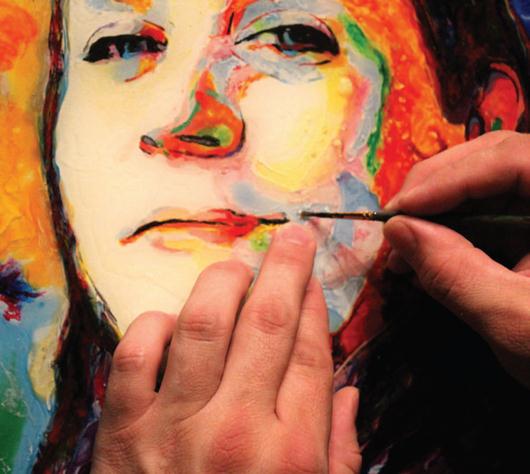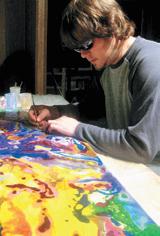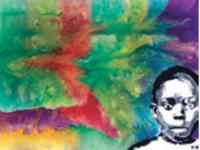John Bramblitt has Discovered a New Way to Bring His Artistic Vision to Life

Throughout most of his life, John Bramblitt, 39, turned to drawing or writing whenever his seizures became too much to bear. Creating something offered him respite from the disruptive convulsions, countless hours in the hospital and missed days of his childhood that were part of growing up with severe epilepsy, a neurological disorder that causes bursts of hyperactivity in the brain. But when Bramblitt lost his vision 10years ago because of damage caused by the disorder, he thought that his ability to create and enjoy art was gone forever. The El Paso, Texas, native describes the first year of his blindness as a nightmare. He lost independence, and it took so much time and effort to relearn how to do things for himself (like cook and read using Braille)that the thought of sketching a person or a scene was inconceivable at the time.
Bramblitt says that it was like being in a deep, dark hole. His depression was suffocating.“[Art had been] an outlet, and I never thought I would lose that,” Bramblitt explains during a phone interview from his home in Denton, Texas. “All you need to draw or write is just a piece of paper and a pencil and you’re good. You can do it. There’s no way you can lose that. And I did.”

Then one day in 2002, Bramblitt decided to start painting again. He considered doing something that is regarded as visual to be almost an act of defiance—and he was ready to defy expectations. He took out a tube of white Elmer’s glue and started making lines on a canvas. When dry, the ridges provided a guide for placing the rich oil colours with his brush. His first painting was a self-portrait. It showed the gentle, shaggy-haired covering his eyes. Over time, Bramblitt learned to distinguish between the textures and densities of different colours of paint with his fingers—his hands essentially taking over the work his eyes had done. Today, he uses a special quick-drying paint rather than glue, and creates detailed, vibrantly coloured paintings of everything from people to horses to wine bottles.

Oil painting gave Bramblitt a new way to see things. “The world is so much more colourful now than when I was sighted,” he says. “It’s so much more vibrant. Colour means a lot more to me now. Before, colours were just whatever light happened to bounce off and reflect back in my eye. That’s just such a boring way of seeing the world. But now it’s emotional. Whenever I hear music, I see colour, and the emotions from people make colour.”Painting also proved to be an outlet to cope with his vision loss and epilepsy. It gave Bramblitt purpose and made him feel less of a burden on friends and family, which was one of his biggest fears while growing up. His parents, Gary and Debbie, had been a constant support to their only child throughout his ongoing health issues, which included kidney dysfunction and Lyme disease. “You’d think, with all that, maybe my childhood wouldn’t have been that great, but it was fantastic because of my friends and my family,” Bramblitt says. “I never really felt like I was sick or anything.” In fact, his parents even let him ride a motorcycle, waterski and take kung fu lessons between extended hospital stays during his youth.
His parents have been a strong force in his life, and Bramblitt, now married and a father to three-year-old Jackson, understands that it must have been hard on his folks to see their son struggle. They felt that they were forced to let go of certain dreams that they had for their child. But then he showed them the possibility of new dreams.
Bramblitt never expected to be a professional painter. At one time, he was considering a career in computers, another of his passions. Drafting and technical drawing were things that he did just for fun in high school. Sketches would frequently pile up, never to be seen by anyone else. It was only after his vision loss and rediscovery of art that a paintbrush became like another appendage.
He painted non-stop between his creative writing classes at the University of North Texas, where he earned an English degree. In fact, within two weeks from the day he began painting, every nook in his cramped two-bedroom apartment was filled with artwork. Eventually, visiting friends couldn’t help but notice the realistic portraits and paintings of landscapes.
One of his buddies suggested that he submit his paintings to a nearby café that displayed the work of local artists. A newspaper picked up Bramblitt’s story, and then a non-profit organization heard about him and asked if he could give a talk on art to a group of children.
Since then, he’s made art his career, painting nearly every day and receiving broad acclaim for his bold work. He has sold his pieces in more than 20 countries. Each painting comes either from his memories or from someone or something he’s just encountered. He uses his hands to imprint a 3-D image of the person or object into his mind and spends about two to four weeks on each piece.

His wife of four years, Jacqi Serie, is his biggest fan. Serie, who has a degree in fine arts, was amazed by Bramblitt’s work when they met in 2003. Like others, she’s still in awe of his ability to paint without sight. “Amazing. That’s the general consensus,” she says. “People look at his work and they’re floored with how realistic it is. I definitely was intrigued at first. After being just consumed by his sort of world of art, in dating him, and having these conversations, I was just amazed. I wished I could do it.”For his part, Bramblitt says that he’s most proud of the time he spends sharing his love of art with non-profit organizations, schools and foundations. He was honoured with the U.S. Presidential Award for volunteerism in 2005, 2006 and 2007 for bringing free art workshops to people (particularly children)who live in neighbourhoods without access to instruction. He spends about 600 hours a year lecturing and leading workshops. He’s even made videos for teachers who work in schools without art programs or who want to teach their students about disabilities. Bramblitt wants to continue helping people get turned on to art. He’s currently working on some e-books and videos that will be offered free online.
Bramblitt says that he feels like he can achieve anything he puts his mind to, now. Art has given him back his dreams—and his life. “That was the worst thing when I lost my eyesight at the beginning. I lost hope. I didn’t have dreams. Now, whatever I try, I may fail. But that doesn’t bother me in the least. I feel like I can try and work towards anything I want to, and that’s just a wonderful feeling.”














